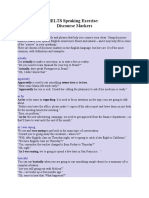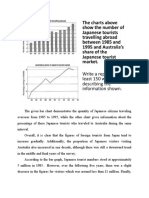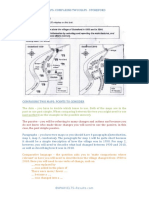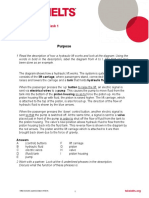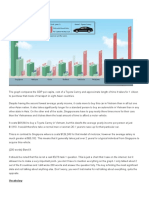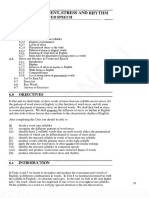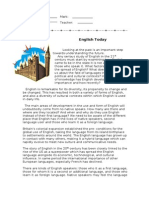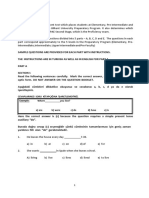Exercise 1: Looking For Information at Speed
Exercise 1: Looking For Information at Speed
Uploaded by
truongthikhaCopyright:
Available Formats
Exercise 1: Looking For Information at Speed
Exercise 1: Looking For Information at Speed
Uploaded by
truongthikhaOriginal Title
Copyright
Available Formats
Share this document
Did you find this document useful?
Is this content inappropriate?
Copyright:
Available Formats
Exercise 1: Looking For Information at Speed
Exercise 1: Looking For Information at Speed
Uploaded by
truongthikhaCopyright:
Available Formats
Exercise 1
Looking for information at speed
The bar chart below shows the results of a questionnaire to find why native
and non-native speakers of English at a university in Australia learn
languages. The questionnaire was given to 1,000 students.
R easo n s fo r learn in g lan g u ag es
100
90
80
70
60
50
%
40
30
20
10
0
t
e
en
ing
cts
le
l
k
ve
ag
or
ab
pe
dy
ra
rw
gu
lop
joy
rt
s tu
os
lan
fo
fo
En
ve
pr
ul
or
n
ul
de
job
ef
ow
ef
nt
Us
al
Us
es
r ta
es
on
ov
ov
po
rs
pr
pe
pr
Im
Im
Im
es
ov
pr
Im
N ative s peakers N on-native s peakers
© Macmillan Publishers Ltd 2005
Taken from the Exams section in www.onestopenglish.com
As you prepare for IELTS you need to develop your speed in using language
and finding information from a graph, chart or diagram. Write down the
answers to the questions below about the bar chart as quickly as you can.
Remember to write the information accurately.
1. What does the bar chart show? __________________
2. How many students participated in the survey? __________________
3. Where were the students from? __________________
4. Which of the two groups was more positive
about language learning? __________________
5. Which reason comes top among non-native
speakers of English? __________________
6. What is the percentage? __________________
7. What percentage of native speakers
found language learning useful for work? __________________
8. What percentage of second language speakers
found language acquisition useful for work? _______________
9. Which reason comes top among native
speakers? __________________
10. What is the percentage? __________________
11. Which reason comes bottom among native
speakers? __________________
12. What is the percentage? __________________
© Macmillan Publishers Ltd 2005
Taken from the Exams section in www.onestopenglish.com
Exercise 2
Write sentences for each piece of information from the chart.
Examples:
1. The bar chart shows the results of a survey.
2. One thousand students took part in the survey.
3. The students were from a university in Australia.
Use the sentences to help you make a continuous text.
Example:
The bar chart shows the results of a survey on the reasons behind learning
languages among 1,000 native and non-native speakers of English at a
university in Australia.
© Macmillan Publishers Ltd 2005
Taken from the Exams section in www.onestopenglish.com
Exercise 3
Partially jumbled text
In the model answer below, nine parts of the text have been jumbled. Put
the words in the right order and write out the whole text.
The bar chart shows the results of a survey on the reasons behind learning
languages among 1,000 native and non-native speakers of English at a
university in Australia.
The 1chart striking most the feature of is that those students 2for mother not
English whom their is tongue had a more positive attitude to language
learning than native speakers. 3prospects in is job Improvement mentioned by
just over 90% of non-native speakers as an incentive to acquiring languages,
4
for by closely usefulness followed travel and work and importance for
studying at 90, 90 and just below 90 respectively. In this group, personal
development improvement 5bottom 70% with comes.
This 6attitude contrasts acquisition sharply language with to that of native
speakers, whose approval was lower than non-native speakers on all
accounts. While improvement in job prospects, for example, 7the attracted
with approval giving most 60% it as a reason, this was considerably less than
for non-native speakers. Usefulness for work and improvement in personal
development 8next came of at respondents 50%. Only 20% of native
speakers, however, 9 think enjoyable is languages learning with only 25%
considering it important for studying.
So it is clear that native speakers of English are more negative about learning
languages than non-native speakers.
© Macmillan Publishers Ltd 2005
Taken from the Exams section in www.onestopenglish.com
Text with blanks
The bar chart shows the results of a survey on the reasons behind learning
languages among 1,000 native and non-native speakers of English at a
university in Australia.
The 1___________________ is that those students 2___________________
had a more positive attitude to language learning than native speakers.
3
___________________ by just over 90% of non-native speakers as an
incentive to acquiring languages, 4___________________ travel and work
and importance for studying at 90, 90 and just below 90 respectively. In this
group, personal development improvement 5___________________.
This 6___________________ of native speakers, whose approval was lower
than non-native speakers on all accounts. While improvement in job
7
prospects, for example, ___________________ as a reason, this was
considerably less than for non-native speakers. Usefulness for work and
improvement in personal development 8___________________. Only 20% of
9
native speakers, however, ___________________ with only 25%
considering it important for studying.
So it is clear that native speakers of English are more negative about learning
languages than non-native speakers.
© Macmillan Publishers Ltd 2005
Taken from the Exams section in www.onestopenglish.com
Exercise 4
More complex jumble
In the model answer below nine parts of the text have been jumbled. Put
the words in the right order and write out the whole text.
The bar 1languages native shows and results the among a of on the
reasons learning survey 1,000 behind chart non-native speakers of English
at a university in Australia.
The 2chart striking most that those the feature of is students 3for positive
had mother not English whom learning their is tongue a more attitude to
language than native speakers. 4prospects by in is job over improvement
90% mentioned just of non-native speakers as an incentive to acquiring
5
languages, for by and closely travel work and usefulness followed
importance for studying at 90, 90 and just below 90 respectively. In this group,
personal 6bottom development 70% with improvement comes.
7
this contrasts attitude native sharply language with to acquisition that
of speakers, whose approval was lower than non-native speakers on all
accounts. While improvement in job prospects, for example, 8the attracted a
with as it approval giving most 60% reason, this was considerably less than
for non-native speakers. Usefulness for work and 9personal in improvement
next development came of at respondents 50%. Only 20% of native
10
speakers, however, think enjoyable considering is languages learning
with it only 25% important for studying.
So it is clear that native speakers of English are more negative about learning
languages than non-native speakers.
© Macmillan Publishers Ltd 2005
Taken from the Exams section in www.onestopenglish.com
Exercise 5
Find the following words in the text below relating to the chart in
Exercise 1. What other words or phrases can replace them.
1. striking
2. feature
3. mentioned
4. just over
5. comes
6. however
7. acquiring
8. on all accounts
9. considerably
10. while
11. respondents
The bar chart shows the results of a survey on the reasons behind learning
languages among 1,000 native and non-native English speakers at a
university in Australia.
The most striking feature of the chart is that those students for whom English
is not their mother tongue had a more positive attitude to language learning
than native speakers. Improvement in job prospects is mentioned by just over
90% of non-native speakers as an incentive to acquiring languages, followed
closely by usefulness for travel and work and importance for studying at 90,
90 and just below 90 respectively. In this group, personal development
improvement comes bottom with 70%.
This attitude to language acquisition contrasts sharply with that of native
speakers, whose approval was lower than non-native speakers on all
accounts. While improvement in job prospects, for example, attracted the
most approval with 60% giving it as a reason, this was considerably less than
for non-native speakers. Usefulness for work and improvement in personal
development came next at 50% of respondents. Only 20% of native speakers,
© Macmillan Publishers Ltd 2005
Taken from the Exams section in www.onestopenglish.com
however, think learning languages is enjoyable with only 25% thinking it
important for studying.
So it is clear that native speakers of English are more negative about learning
languages than non-native speakers.
© Macmillan Publishers Ltd 2005
Taken from the Exams section in www.onestopenglish.com
Exercise 6
In the text below replace the words and phrases with synonyms. There
will be more than one answer in each case.
The bar chart 1provides information about the results of a survey on the
reasons behind learning languages among 1,000 native and non-native
English speakers at a university in Australia.
The most 2noticeable 3characteristic of the chart is that those students for
whom English is not their mother tongue had a more positive attitude to
language learning than native speakers. Improvement in job prospects is
4
quoted by just over 90% of non-native speakers as a/an 5reason for
learning languages, followed closely by usefulness for travel and work and
6
importance for studying at 90, 90 and almost 90 respectively. In this
7
category, personal development improvement 8is 9last with 70%.
10
This attitude to language acquisition is the opposite of native speakers,
11
whose approval was lower than non-native speakers for all items.
12
Whereas improvement in job prospects, for example, attracted the most
13
approval with 60% giving it as a reason, this was significantly less than for
non-native speakers. Usefulness for work and improvement in personal
14
development came next at 50% of those sampled. Only 20% of native
speakers, however, think learning languages is enjoyable with only 25%
15
regarding it important for studying.
So it is clear that native speakers of English are more negative about learning
languages than non-native speakers.
© Macmillan Publishers Ltd 2005
Taken from the Exams section in www.onestopenglish.com
Exercise 7
In the text below some of the words and phrases underlined are not
quite right. Decide which ones are wrong and replace them with a word
or phrase that fits. There will be more than one answer in each case.
The bar chart 1provides informations about the results of a survey on the
reasons behind learning languages among 1,000 native and non-native
English speakers at a university in Australia.
The most 2clear 3point of the chart is that those students for whom English is
not their mother tongue had a more positive attitude to language learning than
native speakers. Improvement in job prospects is 4quoted by just over 90% of
non-native speakers as an 5cause for learning languages, followed closely
by usefulness for travel and work and importance for studying at 90, 90 and
6
around 90 respectively. In this 7 bunch, personal development improvement
8
is 9last with 70%.
This attitude to language acquisition 10contrasts with native speakers, whose
11 12
approval was lower than non-native speakers for all. However,
improvement in job prospects, for example, attracted the most approval with
13
60% giving it as a reason, this was significantly less than for non-native
speakers. Usefulness for work and improvement in personal development
14
came next at 50% of them. Only 20% of native speakers, however, think
15
learning languages is enjoyable with only 25% seeing it important for
studying.
So it is clear that native speakers of English are more negative about learning
languages than non-native speakers.
© Macmillan Publishers Ltd 2005
Taken from the Exams section in www.onestopenglish.com
Exercise 8
Read the text below and use the notes in the column on the right to help
you decide if corrections are needed to the text.
The bar chart shows results of a survey on the 1. A word missing?
reasons behind learning langauges among 1,000 2. Spelling?
native and non-native English speaker at a 3. Singular?
university in Australia.
The striking feature of the chart is that those 4. A word missing?
students for whom English is not thier mother 5. Spelling? Tense?
tongue have a more positive atitude to language 6. Spelling? Singular?
learning than native speaker. Improvement in job
prospects was mentioned by just over 80% of 7. Correct data?
non-native speakers as a persuasion to 8. Correct word?
acquiring, followed closely by usefulness for 9. Spelling?
travel and work and importance for studying at 10. Tense?
90, 90 and just below 90 respectivly. In this
group, personal development improvement came 11. Tense?
bottom with 70%.
This attitude to language acquisition contrasted
sharply with that of native speakers, whose 12. Singular/plural?
approval was lower than non-native speakers on
all account. While improvement in job prospects,
for example, attracted the most approval with
60% give it as a reason, this was considerably
less than for non-native speakers. Usefulness for
work and improvement in personal development
came next at 50% of respondents. Only 20% of
native speakers, though, think earning languages 13. Correct verb
is enjoyable with only 25% thinking it important form?
for studying. 14. Correct register?
15. Spelling?
So it is clear that native speakers of English are
more negative about learning languages than
non-native speakers.
© Macmillan Publishers Ltd 2005
Taken from the Exams section in www.onestopenglish.com
Exercise 9
In the text below parts of the text are missing. Complete the text below
paying particular attention to the spelling and grammatical structure.
The bar chart shows the res1________________________________hind
learning languages among 1,000 native and non-native English speakers at a
university in Australia.
The most strik2_____ture of the chart is that those students for 3______glish
is not their mother tongue had a more positive attitude to language learning
than native speakers. Improvement in job prospects was
4
ment ________________________% of non-native speakers as an
incent5__________________guages closely by usefulness for travel and work
and importance for studying at 90, 90 and just below 90 respectively. In this
group, pers6______________________ement came bottom with 70%.
This attitude to language acquisition
contr7___________________________tive speakers, whose approval was
lower than non-native speakers on all accounts. While improvement in job
prospects, for example, attrac8________________al with 60% giving it as a
reason, this was considerably less than for non-native speakers. Usefulness
for work and improvem9_________________________________ext at 50%
of respondents. Only 20% of native speakers, however, think learning
languages is enjoyable with only 25% think10__________tant for studying.
So it is clear that native speakers of English are more negative about learning
languages than non-native speakers.
© Macmillan Publishers Ltd 2005
Taken from the Exams section in www.onestopenglish.com
Exercise 10
Dictation
Complete the missing details on the graph below.
R e a s o n s fo r _ _ _ _ _ _ 1 _ _ _ _ _ _ _ _ _
100
90
80
70
60
_____2_____
50
40
30
20
10
0
e
ing
_
__
_
__
ag
__
__
__
__
__
dy
gu
__
__
__
_
_4
stu
lan
_3
_5
_6
_7
__
r
__
__
__
wn
fo
__
__
__
__
__
nt
so
__
rta
ve
po
o
pr
Im
Im
© Macmillan Publishers Ltd 2005
Taken from the Exams section in www.onestopenglish.com
Chart 1 for multiple use
________________
100
90
80
70
60
50
40
30
20
10
0
_
__
__
__
__
_
__
_
__
__
_
_
__
__
__
__
__
_
__
__
_
_
__
__
__
__
__
__
_
__
_
__
__
__
__
__
__
© Macmillan Publishers Ltd 2005
Taken from the Exams section in www.onestopenglish.com
Chart 2 for multiple use
________________
100
90
80
70
60
50
40
30
20
10
© Macmillan Publishers Ltd 2005
Taken from the Exams section in www.onestopenglish.com
Chart 3 for multiple use
________________
_
___
__
__
_
__
__
_
__
__
__
__
__
_
__
__
__
__
__
__
__
__
_ _
__
__
__
_
___
0 20 40 60 80 100
__
__
© Macmillan Publishers Ltd 2005
Taken from the Exams section in www.onestopenglish.com
Chart 4 for multiple use
110
100
90
80
70
60
50
40
30
20
10
0
__
__
__
__
__
__
__
__
__
__
__
__
__
__
__
__
__
__
__
__
__
__
__
__
__
__
__
__
__
_
__
__
__
__
__
__
__
__
__
__
__
__
__
__
__
__
__
__
_
__
__
__
__
__
__
© Macmillan Publishers Ltd 2005
Taken from the Exams section in www.onestopenglish.com
You might also like
- (Ms. Truc) BAR CHARTS - No Change Over TimeDocument11 pages(Ms. Truc) BAR CHARTS - No Change Over TimeÁi Nhân Trần ThịNo ratings yet
- IELTS Reading Section - Additional PracticeDocument27 pagesIELTS Reading Section - Additional PracticeNathalia Parra AmórteguiNo ratings yet
- ACADEMIC WRITING - Cinema-TrendsDocument2 pagesACADEMIC WRITING - Cinema-TrendsMarlene50% (2)
- Lady Lazarus by Sylvia PlathDocument4 pagesLady Lazarus by Sylvia PlathPaul MejoradaNo ratings yet
- IELTS Reading Section 1Document4 pagesIELTS Reading Section 1Liz ColoNo ratings yet
- Paragraph Headings For IELTS AcademicDocument6 pagesParagraph Headings For IELTS AcademicJyothiNo ratings yet
- IELTS Speaking Exercise: Discourse MarkersDocument4 pagesIELTS Speaking Exercise: Discourse Markersjavier rocha0% (1)
- Writing Task 1Document2 pagesWriting Task 1Nina MoradaNo ratings yet
- Writing Task 1 - Sample Diagram - ProcessDocument18 pagesWriting Task 1 - Sample Diagram - ProcessTạ Ngọc ThắngNo ratings yet
- City Bank Customer Service Log TestDocument8 pagesCity Bank Customer Service Log TestAnupama BiswasNo ratings yet
- Line GraphDocument6 pagesLine GraphLuna ShimizuNo ratings yet
- Unlimited World - Collection of TOEFL ITP Structure & Written Expression TestDocument2 pagesUnlimited World - Collection of TOEFL ITP Structure & Written Expression Testwega96No ratings yet
- Mixed Graph FormDocument3 pagesMixed Graph FormTrương HằngNo ratings yet
- Task 1 - Maps - StokefordDocument2 pagesTask 1 - Maps - StokefordLuxubu Hehe100% (1)
- Academic Writing Task 1 Worksheet 1: PurposeDocument7 pagesAcademic Writing Task 1 Worksheet 1: PurposeNguyễn Hà MyNo ratings yet
- IELTS Writing Academic Task 1 Ver4Document10 pagesIELTS Writing Academic Task 1 Ver4siewyonglimNo ratings yet
- Grimms Law KeyDocument2 pagesGrimms Law KeyFrancesc Oromí SoldevilaNo ratings yet
- Reading Passage 2: Universities in BritainDocument4 pagesReading Passage 2: Universities in Britainvo nguyen thanh tranh100% (2)
- English Grammar, Punctuation and Spelling: Paper 1: QuestionsDocument13 pagesEnglish Grammar, Punctuation and Spelling: Paper 1: QuestionsAlekper Alekperov100% (1)
- Ielts Vocab WorksheetsDocument36 pagesIelts Vocab WorksheetsMannJotNo ratings yet
- English Ielts PracticeDocument20 pagesEnglish Ielts PracticeLepusVasuNo ratings yet
- Sample Paper Ucp Faculty of ItDocument7 pagesSample Paper Ucp Faculty of ItshamaNo ratings yet
- 589 Reading Comprehension Passage 19 MCQ Test With Answers Two Great TraditionsDocument3 pages589 Reading Comprehension Passage 19 MCQ Test With Answers Two Great TraditionsDalga ÖzalNo ratings yet
- Reading TFNG YNNGDocument14 pagesReading TFNG YNNGXiao FengNo ratings yet
- How To Use A DictonaryDocument4 pagesHow To Use A DictonaryCrisPopNo ratings yet
- Opinion Essay: Writing Task 2Document25 pagesOpinion Essay: Writing Task 2Huy BéoNo ratings yet
- E8td Unit 3 Peoples of VietnamDocument9 pagesE8td Unit 3 Peoples of VietnamHau NguyenNo ratings yet
- Tests of Skills3Document99 pagesTests of Skills3basalshari78No ratings yet
- Aberration: Abhor: Acquiesce: Alacrity: Amiable: Appease: Arcane: Avarice: Brazen: Brusque: Cajole: Callous: CandorDocument5 pagesAberration: Abhor: Acquiesce: Alacrity: Amiable: Appease: Arcane: Avarice: Brazen: Brusque: Cajole: Callous: CandorKemal ŞENYILMAZNo ratings yet
- The Two Cultures: A Problem For The Twenty-First Century?: IELTS Text 002Document5 pagesThe Two Cultures: A Problem For The Twenty-First Century?: IELTS Text 002ruchi sharma0% (1)
- Adverbs of DegreeDocument6 pagesAdverbs of Degreesakura2789100% (3)
- IELTS Practice Speaking Test #3: PART 1 - Two or Three Complex Sentences For Each AnswerDocument1 pageIELTS Practice Speaking Test #3: PART 1 - Two or Three Complex Sentences For Each AnswerDaniel SanchezNo ratings yet
- Unit Word Accent, Stress and Rhythm IN: Connected SpeechDocument26 pagesUnit Word Accent, Stress and Rhythm IN: Connected SpeechShantanu GhoshNo ratings yet
- Business English Vocabulary - AdvertisingDocument2 pagesBusiness English Vocabulary - AdvertisingLea KroegerNo ratings yet
- Ielts ListeningDocument21 pagesIelts ListeningNaufal AdityoNo ratings yet
- Reading Passage 1: How Mobile Telephony Turned Into A Health ScareDocument15 pagesReading Passage 1: How Mobile Telephony Turned Into A Health ScareNiku SaiyanNo ratings yet
- 839 Advanced Level Grammar Exercise MCQ Test 16Document3 pages839 Advanced Level Grammar Exercise MCQ Test 16sohailfaisal2006No ratings yet
- Paraphrase Synonyms BDocument3 pagesParaphrase Synonyms BArvind StarrNo ratings yet
- Writing Mock Test With Sample AnswDocument5 pagesWriting Mock Test With Sample AnswmaniNo ratings yet
- Speaking GuidepdfDocument5 pagesSpeaking GuidepdfJoshua JethrohNo ratings yet
- HANDOUT-Oral Presentation Dos and Don'TsDocument2 pagesHANDOUT-Oral Presentation Dos and Don'TsPoloniuNo ratings yet
- English Today TestDocument4 pagesEnglish Today TestDullah ZunguNo ratings yet
- IELTS Speaking Lesson 123Document46 pagesIELTS Speaking Lesson 123md shahidullahNo ratings yet
- Writing Guides From BBC Skills WiseDocument6 pagesWriting Guides From BBC Skills WisedanielamuncaNo ratings yet
- Restaurants: 5 Listening & SpeakingDocument3 pagesRestaurants: 5 Listening & SpeakingAlvaro ScorzaNo ratings yet
- PAE Stage 1Document9 pagesPAE Stage 1ece atagünNo ratings yet
- SSU Job InterviewDocument63 pagesSSU Job Interviewo HAPPY oNo ratings yet
- Listening SimonDocument60 pagesListening SimonNicotinyl HakunanatNo ratings yet
- Listening Practice Test 1: Instructions To CandidatesDocument2 pagesListening Practice Test 1: Instructions To Candidatesakbar2jNo ratings yet
- Ideas, Opinions and Vocabulary For IELTS Writing Task 2Document51 pagesIdeas, Opinions and Vocabulary For IELTS Writing Task 2wzqNo ratings yet
- Unit PlanDocument13 pagesUnit Planapi-377763349No ratings yet
- Online Class - XII/2077Document17 pagesOnline Class - XII/2077zoom100% (1)
- Ote-B2-Practice-Test1 Converted by Onlinepdfedit ComDocument27 pagesOte-B2-Practice-Test1 Converted by Onlinepdfedit ComMario Izquierdo JiménezNo ratings yet
- AQA French GCSE PhotocardsDocument80 pagesAQA French GCSE Photocardsvijayshetty sNo ratings yet
- Test 1 A: Passage 1: The Natural of YawningDocument40 pagesTest 1 A: Passage 1: The Natural of YawningKelvinNo ratings yet
- 7.1 (PDF AT Task 1) Tenses PDFDocument4 pages7.1 (PDF AT Task 1) Tenses PDFP A Wan SunarNo ratings yet
- 0510 s17 Ms 21 PDFDocument11 pages0510 s17 Ms 21 PDFMahmoud GomaaNo ratings yet
- Describing Bar Chart Practice 3Document7 pagesDescribing Bar Chart Practice 3Irfan HasifNo ratings yet
- 10 SCL TaposDocument44 pages10 SCL TaposRoss Elmar OrolfoNo ratings yet
- Passive Battleship Game - WorksheetDocument1 pagePassive Battleship Game - WorksheetricardogonzalezdjNo ratings yet






